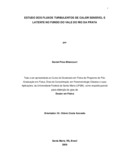| dc.creator | Bitencourt, Daniel Pires | |
| dc.date.accessioned | 2017-05-05 | |
| dc.date.available | 2017-05-05 | |
| dc.date.issued | 2008-03-07 | |
| dc.identifier.citation | BITENCOURT, Daniel Pires. Estudo dos fluxos turbulentos de calor sensível e latente no fundo do vale do rio da prata. 2008. 143 f. Tese (Doutorado em Física) - Universidade Federal de Santa Maria, Santa Maria, 2008. | por |
| dc.identifier.uri | http://repositorio.ufsm.br/handle/1/3877 | |
| dc.description.abstract | Three observational campaigns have been conducted in the region of Nova Roma do Sul, southern Brazil. In the last one of them, a micrometeorological tower was deployed above the river surface, at the bottom of the Prata river valley. The purpose was to characterize the exchange between the river surface and the atmosphere. The micrometeorological parameters measured at this tower were analyzed and compared to the synoptic meteorological variables. The comparisons showed a connection between the large-scale flow and the local circulations. Differently than usually observed, the vertical turbulent sensible and latent heat fluxes were directed towards the surface at daytime. The physical processes responsible for this behavior are analyzed, using a large eddy simulation model. Seven simulations were performed, to understand how the exchange is affected by the topography, and by the magnitude and direction of the large scale flow. The results show that the vertical fluxes are directed towards the surface, independently of the existence of slopes besides the river. Large scale wind direction has a stronger effect on the flux magnitude than does its magnitude. Two additional simulations were performed, to understand how the fluxes at the valley bottom are affected by the river width. For these simulations, rivers twice and for times as wide as in the previous runs were considered. The results show that, even when the river occupied as much as one third of the total horizontal domain, it still remains with a passive behavior, with the exchange above its surface being controlled by the characteristics of the air that is transported from above the land portion of the domain. The river, in this case is a heat and moisture sink, at daytime. Furthermore, the horizontal fluxes, that converge from the slopes towards the air above the river have a fundamental role on the
exchange process between the river and local atmosphere. | eng |
| dc.format | application/pdf | por |
| dc.language | por | por |
| dc.publisher | Universidade Federal de Santa Maria | por |
| dc.rights | Acesso Aberto | por |
| dc.subject | Mesoescala | por |
| dc.subject | Modelagem numérica | por |
| dc.subject | Terreno complexo | por |
| dc.subject | Micrometeorologia | por |
| dc.title | Estudo dos fluxos turbulentos de calor sensível e latente no fundo do vale do Rio da Prata | por |
| dc.type | Tese | por |
| dc.description.resumo | A campanha experimental de 2005, realizada em Nova Roma do Sul RS, contou com a instalação de uma torre micrometeorológica em lugar inédito. Os sensores
foram posicionados sobre a superfície da água, no fundo do vale do rio da Prata, com objetivo de caracterizar as transferências entre a superfície do rio e a atmosfera. Todos os parâmetros micrometeorológicos medidos por essa torre foram avaliados e comparados com variáveis meteorológicas de escala sinótica. As comparações apontaram para uma conexão entre o escoamento de grande escala e
as circulações locais. Diferentemente do que normalmente ocorre, os fluxos turbulentos verticais de calor sensível e latente apresentaram sinal negativo durante o dia. Os processos físicos responsáveis por essa conduta são estudados com o uso de um modelo LES. Sete simulações foram utilizadas para testar a contribuição da topografia e da direção e velocidade do escoamento sinótico sobre as trocas
verticais. Notou-se que os fluxos verticais são negativos independentemente da presença das encostas e que a magnitude desses fluxos é mais influenciada pela
direção do que pela velocidade do vento sinótico. O ambiente no fundo do vale foi modificado numericamente através de mais duas rodadas do LES. A conduta dos fluxos verticais de calor e umidade entre o ar e o rio foram testadas com o nível do rio mais elevado, em 19,8 e 86 metros, transformando a largura da área alagada de 80 para 160 metros e de 80 para 320 metros, respectivamente. Percebeu-se que com o rio ocupando até 1/3 do domínio do modelo, este ainda permanece com papel passivo, ou seja, atuando como sumidouro de calor e umidade. Percebeu-se também que os fluxos horizontais, convergindo das encostas para cima do rio,
possuem papel fundamental no processo de trocas verticais entre o rio e a atmosfera local. | por |
| dc.contributor.advisor1 | Acevedo, Otavio Costa | |
| dc.contributor.advisor1Lattes | http://lattes.cnpq.br/8696858608013659 | por |
| dc.contributor.referee1 | Dias, Maria Assuncao Faus da Silva | |
| dc.contributor.referee1Lattes | http://lattes.cnpq.br/3519989612857544 | por |
| dc.contributor.referee2 | Degrazia, Gervásio Annes | |
| dc.contributor.referee2Lattes | http://lattes.cnpq.br/3195210233978887 | por |
| dc.contributor.referee3 | Moraes, Osvaldo Luiz Leal de | |
| dc.contributor.referee3Lattes | http://lattes.cnpq.br/0593135962205202 | por |
| dc.creator.Lattes | http://lattes.cnpq.br/6829223218818925 | por |
| dc.publisher.country | BR | por |
| dc.publisher.department | Física | por |
| dc.publisher.initials | UFSM | por |
| dc.publisher.program | Programa de Pós-Graduação em Física | por |
| dc.subject.cnpq | CNPQ::CIENCIAS EXATAS E DA TERRA::FISICA | por |


